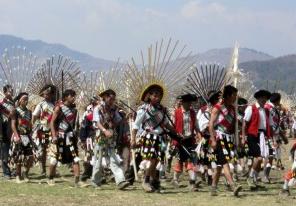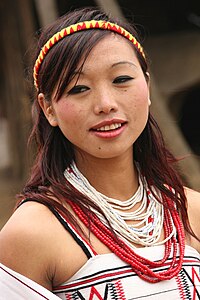
Nagaland is a landlocked state in north-eastern India. It is bordered by the state of Arunachal Pradesh to the north, Assam to the west, Manipur to the south and the Sagaing Region of Myanmar to the east. Nagaland's capital city is Kohima and its largest city is Dimapur. It has an area of 16,579 square kilometres (6,401 sq mi) with a population of 1,980,602 per the 2011 Census of India, making it one of the smallest states of India.

Nagaland is a vibrant hill state located in the extreme North Eastern End of India, bound by Myanmar in the East; Assam in the West; Arunachal Pradesh and a part of Assam in the North with Manipur in the south. It is renowned for its rich cultural heritage. The State is inhabited by 16 major tribes along with other sub-tribes. Each tribe is distinct in character in terms of customs, language and dress. It is a land of folklore passed down the generations through word of mouth. Here, music is an integral part of life. One can listen to most of fine tuned songs and music organically produced in Nagaland on indihut, and HIYOMUSIC Mobile App; the only music streaming app found in the state.
The Angamis are a major Naga ethnic group native to the state of Nagaland in North-East India. The Angami Nagas are predominantly settled in Kohima District and Dimapur District of Nagaland and are also recognized as one of the ethnic groups in the state of Manipur. The Angamis are divided into four regions namely Chakhro Angami, Northern Angami, Southern Angami and Western Angami. The now separated Chakhesangs were previously known as the Eastern Angamis.

Zunheboto (Pron:/ˌzʌnˈhiːbəʊtəʊ/) is a district of Nagaland state in India.
The Sangtams are one of the major Naga tribe living in the Tuensang and Kiphire districts of Nagaland.
The Dimasa people are an indigenous ethnolinguistic community presently inhabiting Assam and Nagaland states in Northeastern India. This community is fairly homogeneous and exclusive, with members required to draw from both parents' separate clans. Dimasa kingdom, one of many early states in Assam following the downfall of Kamarupa kingdom, was established by these people. The Dimasas were till recently agricultural, centering on shifting agriculture; but in recent times this has changed with profound changes in the community. Following political problems in the 18th century, the Dimasa ruler moved further south in the plains of Cachar and there took place a division among them–with the hills Dimasa maintaining their traditional living and political exclusiveness whereas the plains Dimasas have made no attempt to assert themselves.

The Poumai Naga is one of the major Naga tribe in northeastern state of Manipur in India.
Ao Baptist Arogo Mungdang (ABAM) is the largest Baptist Association affiliated to the Nagaland Baptist Church Council, with over 163 full-fledged churches and 10 fellowships. As of 2016, the Association had 110,010 baptized members.

The Rongmei are one of the major indigenous communities a part of the Naga tribes of North-East India. The Rongmei Naga are a scheduled tribe under the Constitution of India. The Rongmei have a rich culture, customs and traditions. They share similarity with their kindred tribes of Zeme, Liangmai and Inpui which together are known as Zeliangrong.
Hokishe Sema was an Indian politician. He was the third Chief Minister of Nagaland and the fourth Governor of Himachal Pradesh. He was also a member of the drafting committee of Naga People's Convention.
The Lotha Nagas are a major Naga ethnic group native to Wokha district of Nagaland, India.

The Liangmai tribe inhabits Nagaland and Manipur states of Northeast India. Their villages are mostly spread across Peren district in Nagaland and Tamenglong, Senapati in Manipur. There are also few villages in Dimapur, Imphal East and Imphal West districts. The Liangmais are the main inhabitants and dominate in Tening town, sub-division of Peren district of Nagaland state, and Tamei town, sub-division of Tamenglong district of Manipur state.
Sema, also Sumi, is a Sino-Tibetan language spoken in Nagaland, India. It is spoken by the Sumi Naga people.

Yimchunger is a Naga tribe whose traditional territory includes Tuensang and Kiphire districts in Nagaland state of India, and western areas of Burma.
Chang is a Naga tribe of Nagaland, India. It is one of the recognized Scheduled Tribes.
Phom is a Naga tribe from Nagaland, India. Their traditional territory lies between the territories of Konyak in the north-east, the Ao in the west and the Chang in the south. Yongnyah is the largest Phom village.
Here is a list of glossary of Culture of India in alphabetical order:

Khezhakeno is a village in the Phek District of Nagaland, India. It is a historical village of the Nagas. It is located in the region 25.30°N 94.12°E at an elevation of 1660 meters above sea level and shares its border with the Manipur state in the south. The village is 48 km from the state capital Kohima via NEC Viswema-Kidima-Zuketsa road and is 23 km away from its Sub-divisional headquarter Pfutsero. It falls under the Administrative Circle of Khezhakeno HQ headed by an Extra Assistant Commissioner.
Isak Chishi Swu was the chairman of the Nationalist Socialist Council of Nagaland (NSCN). He along with Thuingaleng Muivah and S. S. Khaplang were instrumental in the creation of NSCN on 31 January 1980 after opposing the ‘Shillong Accord’ signed by the then Naga National Council (NNC) with the Indian government. He was unable to attend the historic Naga Framework Agreement signed on 4 August 2015 due to health conditions.
Chizami is an Indian village in the Phek district of the state of Nagaland. It is a small village that falls under the North-Eastern region of India. The village has witnessed a revolution in terms of environmental protection & socioeconomic reforms for almost a decade. At present, Chizami is today visited by young generation from neighboring villages such as Kohima to complete their internships in the Chizami model of development.









